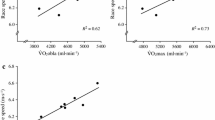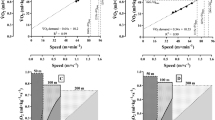Abstract
In swimming competitions, a good maximal oxygen uptake (\( \dot V \)O2max) is well correlated with performance in mid and long distance events. Along \( \dot V \)O2max, oxygen uptake adaptation (\( \dot V \)O kinetic) and oxygen consumption at steady state (\( \dot V \)O2ss) are also important factors that influence the performance. Concerning oxygen kinetic parameters, the primary time constant (τ) seems to play the main role in \( \dot V \)O kinetics. The purpose of this study was to look at a possible relationship between Ừ, as well as other physiologic parameters and performance in 400 m crawl in elite swimmers. Ten elite swimmers were tested in a swimming and in a laboratory in six sessions. \( \dot V \)O2peak and ventilatory threshold (VT) were determined during an incremental to exhaustion test (ET) on an arm crank ergometer. A constant load tests (CT) at 75% (>VT) and 35% (<VT) of \( \dot V \)O2max were performed for both arms (UBE) and legs (LBE) on the arm crank ergometer and a cycle ergometer respectively. A maximal 400m crawl (CR) was also swum and time trial was used as performance best. Peak power output (Wpeak), heart rate (HR), lactate concentration [La−], τ, as well as other physiologic parameters, were also identified. CR significantly correlated with Wpeak (r= 0.81, p<0.01) and HR (r=0.71, p<0.05) in UBE. No significant correlations were found with τ (p>0.05). The results indicate that \( \dot V \)O kinetics, using our protocol, do not seem well correlated with CR in elite swimmers. Further studies are needed to clarify whether either using a swimming flume, or assessing long-distance and short-distance swimmers might give different results.
Similar content being viewed by others
References
Costill ED, Maglischo EW, Richardson AB (1994) La natation. Edition Vigot, Paris, p 27
Basset DR Jr, Howley ET (2000) Limiting factors for maximum oxygen uptake and determinants of endurance performance. Med Sci Sport Exerc 32:70–84
Kimura Y, Yeater RA, Martin RB (1990) Simulated swimming: a useful tool for evaluation the VO2 max of swimmers in the laboratory. Br J Sports Med 24:201–206
Norris SR, Petersen SR (1998) Effects of endurance training on transient oxygen uptake responses in cyclists. J Sports Sci 16:733–738
Grassi B (2005) Delayed metabolic activation of oxidative phosphorylation in skeletal muscle at exercise onest. Med Sci Sports Exerc 37:1567–73
Grassi B (2000) Skeletal muscle VO2 on-kinetics: set by O2 delivery or by O2 utilization? New insights into and old issue. Med Sci Sports Exerc 32:108–116
Hamilton AL, Killian KJ, Summers E, Jones NL (1995) Muscle strength, symptom intensity, and exercise capacity in patients with cardiorespiratory disorders. Am J Respir Crit Care Med 152:2021–2031
Casaburi R, Storer TW, Ben-Dov I, Wasserman K (1987) Effect of endurance training on possible determinants of VO2 during heavy exercise J Appl Physiol 62:199–207
Casaburi R, Storer TW, Wasserman K (1987) Mediation of reduced ventilatory response to exercise after endurance training. J Appl Physiol 63:1533–1538
Kilding AE, Winter EM, Fysh M (2006) A comparison of pulmonary oxygen uptake kinetics in middle and long distance runners. Int J Sports Med 27:419–426
Duffield R, Edge J, Bishop D, Goodman C (2007) The relationship between VO2 slow component, muscle metabolites and performance during very-heavy exhaustive exercise. J Sci and Med Sport 10:127–134
Whipp BJ, Ward SA (1990) Physiological determinants of pulmonary gas exchange kinetics during exercise. Med Sci Sports Exerc 62:62–71
Swaine IL, Winter EM (1999) Comparison of cardiopulmonary responses to two types of dry-land upper-body exercise testing modes in competitive swimmers. Eur J Appl Physiol 80:588–590
Vokac Z, Bell H, Bautz-Holter E, Rodhal K (1975) Oxygen uptake / heart rate relationship in leg and arm exercise, sitting and standing. J Appl Physiol 39:54–59
Lacour JR, Flandrois R (1977) Role of aerobic metabolism in prolonged intensive exercise. J Physiol (Paris) 73:89–130
Burnley M, Doust JH, Jones AM (2006) Time required for the restoration of normal heavy exercise VO2 kinetics following prior heavy exercise. J Appl Physiol 101:1320–1527
Toubekis AG, Tsami AP, Tokmakidis SP (2006) Critical velocity and lactate threshold in young swimmers. Int J Sports Med 27:117–123
Lepretre PM, Foster C, Koralsztein JP, Billat V (2005) Heart rate deflection point as a strategy to defend stroke volume during incremental exercise. J Appl Physiol 98:1660–1665
Borg G (1998). Borg’s Perceived Exertion and Pain Scales. Human Kinetics, Champaign, IL
Åstrand PO, Rodahl K, Dhal HA, Strome SB (2004) Textbook of work physiology. Human Kinetics, Champaign, IL
McArdle WD, Katch FI, Katch VL (1998) Fisiologia Applicata allo Sport, aspetti energetico, nutrizionale e performance. Casa Editrice Ambrosiana, Milan, Italy
Pendergast DR (1989) Cardiovascular, respiratory, and metabolic responses to upper body exercise. Med Sci Sports Exerc 21[Suppl]:121–125
Shephard RJ (1987) Science and medicine of canoeing and kayaking. Sports Med 4:19–33
Miles DS, Cox MH, Bomze JP (1989) Cardiovascular responses to upper body exercise in normals and cardiac patients. Med Sci Sports Exerc 21:126–131
Cerretelli P, Pendergast DR, Paganelli WC, Rennie DW (1979) Effects of specific muscle training on the VO2 on-response and early blood lactate. J Appl Physiol 47:761–769
Bishop D, Bonetti D, Dawson B (2002) The influence of pacing strategy on VO2 and supramaximal kayak performance. Med Sci Sports Exerc 34:1041–1047
Gardner A, Osborne M, D’Auria S, Jenkins D (2003) A comparison of two methods for calculation of accumulated oxygen deficit. J Sports Sci 21:155–162
Sandal LE, Wood DM, Draper SB, James DVB (2006) Influence of pacing strategy on oxygen uptake during treadmill middle-distance running. Int J Sports Med 27:37–42
Gullstrand L, Lawrence S (1987) Heart rate and blood lactate response to short intermittent work at race pace in highly trained swimmers. Austr J Sci Med Sport 19:10–14
Author information
Authors and Affiliations
Corresponding author
Rights and permissions
About this article
Cite this article
Invernizzi, P.L., Caporaso, G., Longo, S. et al. Correlations between upper limb oxygen kinetics and performance in elite swimmers. Sport Sci Health 3, 19–25 (2008). https://doi.org/10.1007/s11332-008-0052-8
Received:
Accepted:
Published:
Issue Date:
DOI: https://doi.org/10.1007/s11332-008-0052-8




